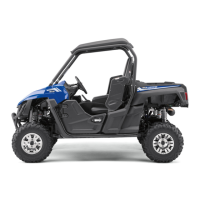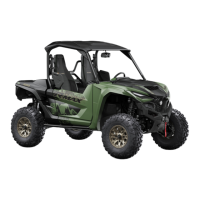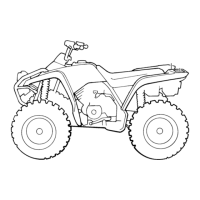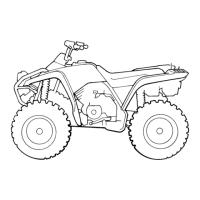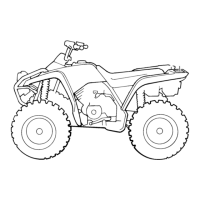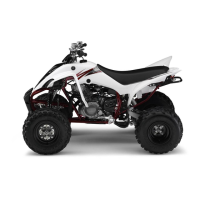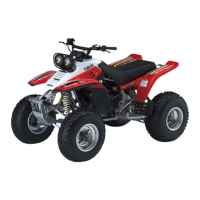Do you have a question about the Yamaha WOLVERINE R-SPEC YXE70WPAJ and is the answer not in the manual?
Explains how specific notations indicate important information for safety and operation.
Emphasizes owner's responsibility for safe operation and instructing others.
Highlights unique handling characteristics and risks associated with off-road vehicles.
Covers operator age, passenger capacity, required safety gear, and pre-operation checks.
Stresses pre-operation checks for safe condition and avoiding accidents.
Details precautions for carrying loads or towing, affecting stability and risk.
Guides on keeping body inside, proper seating, and hazard awareness.
Critical advice on turning, sliding, and abrupt maneuvers to prevent rollovers.
Warns about deadly gas from exhaust and safe operating practices.
Advises on choosing genuine accessories for safety and performance.
Warns about safety hazards from non-genuine parts and modifications.
Advises on selecting appropriate tires and rims for optimal performance.
Identifies key external components of the vehicle's left side.
Identifies key external components of the vehicle's right side.
Illustrates and labels the primary controls and instrument panel features.
Explains the function of the ignition switch positions (Off, On, Start).
Details the meaning and function of various dashboard indicator and warning lights.
Describes the features of the digital display, including speedometer and gauges.
Explains how to read and reset the odometer and tripmeters for distance tracking.
Covers setting the clock, reading hour meter, and displaying battery voltage.
Explains battery voltage readings and potential issues indicated by 'LO' or 'HI'.
Details how to read the fuel gauge and what the display segments indicate.
Explains how the vehicle displays error codes via warning lights and the multi-function display.
Details the operation of the headlight switch for low beam, high beam, and off.
Explains how to select drive modes (2WD, 4WD, DIFF LOCK) for different terrains.
Instructs on how to use the horn.
Explains how to use the accelerator pedal for speed control.
Explains how to use the brake pedal for slowing or stopping the vehicle.
Details how to engage and release the parking brake for securing the vehicle.
Explains the function of the drive select lever for shifting transmission gears.
Instructions for opening and closing the fuel tank cap during refueling.
Instructions on how to open and close the vehicle doors securely.
Instructions on removing and installing seat cushions and ensuring they are secured.
Details how to adjust the driver's seat to one of three positions.
Emphasizes the importance of wearing seat belts and how to use them properly.
Instructions on using the glove compartment for storing items safely.
Describes the location and use of various storage compartments in the vehicle.
Guidance on using cup holders and safety precautions for containers.
Information on cargo bed load limits and warnings against carrying passengers.
Details the components and adjustment features of the front shock absorbers.
Details the components and adjustment features of the rear shock absorbers.
Information on the trailer hitch system and towing equipment.
Explains the use and capacity of the 12-V auxiliary DC jack.
A detailed checklist covering brakes, fuel, oil, coolant, and more.
Verifies brake pedal, fluid level, and operation for safe stopping performance.
Ensures correct engine oil, coolant levels, and proper tire inflation/condition.
Verifies seat belts, steering, cables, and instruments for safe operation.
Covers checking tire pressure, wear limits, and recommended settings.
Critical instructions for the first 20 hours to ensure engine longevity and performance.
Guides on safely starting the engine and operating the drive select lever.
Explains the use of the On-Command drive knob for different terrains.
Safe procedures for parking, loading cargo, and towing trailers.
Highlights unique vehicle characteristics and essential driver qualifications.
Covers passenger requirements, seat belts, and occupant protection systems.
Details on steering wheel grip, PPE, and safe driving maneuvers.
Guidance on turning, accelerating, braking, and operating in various conditions.
Outlines maintenance intervals for emission control and general systems.
Covers engine oil, final gear oil, differential oil, and coolant maintenance.
Instructions for checking brake pads, fluid levels, and replacement procedures.
Covers stabilizer bushes, pivots, steering, wheels, tires, and battery maintenance.
Guidance on fuse replacement, bulb replacement, and headlight adjustment.
Guides for diagnosing starting problems, engine overheating, and other issues.
Detailed instructions on how to clean the vehicle, with safety precautions.
Procedures for preparing the vehicle for long-term storage to prevent deterioration.
Key physical dimensions, weight, and noise/vibration levels.
Details on engine type, displacement, transmission, and clutch.
Specifies recommended fluids, fuel capacity, and filter types.
Specifications for wheels, tires, and the brake system type.
Details on suspension, electrical system components, and indicator lights.
Battery specifications and a list of vehicle fuses with amperage ratings.
Space to record vehicle and model identification numbers for reference.
Location of the model label and its importance for ordering parts.
| Brand | Yamaha |
|---|---|
| Model | WOLVERINE R-SPEC YXE70WPAJ |
| Category | Offroad Vehicle |
| Language | English |
